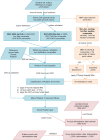High-resolution maps show that rubber causes substantial deforestation
- PMID: 37853124
- PMCID: PMC10632130
- DOI: 10.1038/s41586-023-06642-z
High-resolution maps show that rubber causes substantial deforestation
Abstract
Understanding the effects of cash crop expansion on natural forest is of fundamental importance. However, for most crops there are no remotely sensed global maps1, and global deforestation impacts are estimated using models and extrapolations. Natural rubber is an example of a principal commodity for which deforestation impacts have been highly uncertain, with estimates differing more than fivefold1-4. Here we harnessed Earth observation satellite data and cloud computing5 to produce high-resolution maps of rubber (10 m pixel size) and associated deforestation (30 m pixel size) for Southeast Asia. Our maps indicate that rubber-related forest loss has been substantially underestimated in policy, by the public and in recent reports6-8. Our direct remotely sensed observations show that deforestation for rubber is at least twofold to threefold higher than suggested by figures now widely used for setting policy4. With more than 4 million hectares of forest loss for rubber since 1993 (at least 2 million hectares since 2000) and more than 1 million hectares of rubber plantations established in Key Biodiversity Areas, the effects of rubber on biodiversity and ecosystem services in Southeast Asia could be extensive. Thus, rubber deserves more attention in domestic policy, within trade agreements and in incoming due-diligence legislation.
© 2023. The Author(s).
Conflict of interest statement
The authors declare no competing interests.
Figures












Comment in
-
Assessing the scale of rubber deforestation in southeast Asia.Nature. 2023 Nov;623(7986):256-257. doi: 10.1038/d41586-023-03153-9. Nature. 2023. PMID: 37875686 No abstract available.
-
Rubber planting and deforestation.Nature. 2025 Aug;644(8076):E20-E22. doi: 10.1038/s41586-025-08848-9. Epub 2025 Aug 13. Nature. 2025. PMID: 40804156 No abstract available.
-
Accuracy of rubber-related deforestation maps.Nature. 2025 Aug;644(8076):E13-E19. doi: 10.1038/s41586-025-08847-w. Epub 2025 Aug 13. Nature. 2025. PMID: 40804157 No abstract available.
References
-
- Goldman, E., Weisse, M. J., Harris, N. & Schenider, M. Estimating the Role of Seven Commodities in Agriculture-Linked Deforestation: Oil Palm, Soy, Cattle, Wood Fiber, Cocoa, Coffee and Rubber (World Resources Institute, 2020).
-
- Hurni, K. & Fox, J. The expansion of tree-based boom crops in mainland Southeast Asia: 2001 to 2014. J. Land Use Sci.13, 198–219 (2018).
-
- Pendrill, F., Persson, U., Kastner, T. & Wood, R. Deforestation risk embodied in production and consumption of agricultural and forestry commodities 2005–2018. Zenodo 10.5281/zenodo.5886600 (2022).
-
- Pendrill, F., Persson, U. & Kastner, T. Deforestation risk embodied in production and consumption of agricultural and forestry commodities 2005–2017. Zenodo 10.5281/zenodo.4250532 (2020).
-
- Gorelick, N. et al. Google Earth Engine: planetary-scale geospatial analysis for everyone. Remote Sens. Environ.202, 18–27 (2017).

